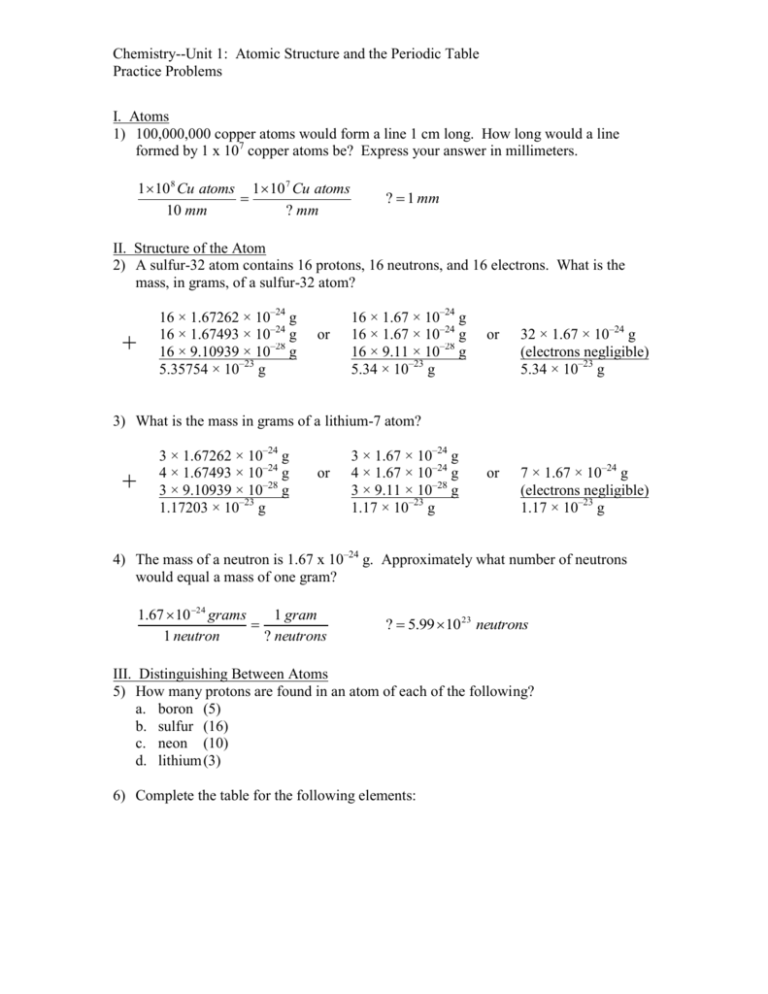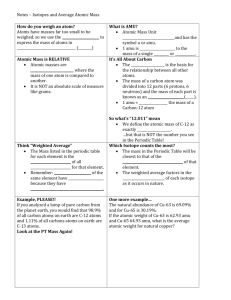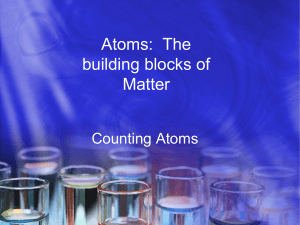Chemistry--Chapter 5: Atomic Structure and the Periodic Table
advertisement

Chemistry--Unit 1: Atomic Structure and the Periodic Table Practice Problems I. Atoms 1) 100,000,000 copper atoms would form a line 1 cm long. How long would a line formed by 1 x 107 copper atoms be? Express your answer in millimeters. 1 10 8 Cu atoms 1 10 7 Cu atoms 10 mm ? mm ? 1 mm II. Structure of the Atom 2) A sulfur-32 atom contains 16 protons, 16 neutrons, and 16 electrons. What is the mass, in grams, of a sulfur-32 atom? + 16 × 1.67262 × 10‒24 g 16 × 1.67493 × 10‒24 g 16 × 9.10939 × 10‒28 g 5.35754 × 10‒23 g or 16 × 1.67 × 10‒24 g 16 × 1.67 × 10‒24 g 16 × 9.11 × 10‒28 g 5.34 × 10‒23 g or 32 × 1.67 × 10‒24 g (electrons negligible) 5.34 × 10‒23 g or 7 × 1.67 × 10‒24 g (electrons negligible) 1.17 × 10‒23 g 3) What is the mass in grams of a lithium-7 atom? + 3 × 1.67262 × 10‒24 g 4 × 1.67493 × 10‒24 g 3 × 9.10939 × 10‒28 g 1.17203 × 10‒23 g or 3 × 1.67 × 10‒24 g 4 × 1.67 × 10‒24 g 3 × 9.11 × 10‒28 g 1.17 × 10‒23 g 4) The mass of a neutron is 1.67 x 10–24 g. Approximately what number of neutrons would equal a mass of one gram? 1 gram 1.67 10 24 grams 1 neutron ? neutrons ? 5.99 10 23 neutrons III. Distinguishing Between Atoms 5) How many protons are found in an atom of each of the following? a. boron (5) b. sulfur (16) c. neon (10) d. lithium (3) 6) Complete the table for the following elements: Chemistry--Unit 1: Atomic Structure and the Periodic Table Practice Problems Element Name Number of Electrons 25 Number of Neutrons 30 Atomic Number Mass Number Manganese Number of Protons 25 Element Symbol 25 55 55 25 Sodium 11 11 12 11 23 Bromine 35 35 45 35 80 23 11 80 35 Yttrium 39 39 50 39 89 Arsenic 33 33 42 33 75 75 33 Actinium 89 89 138 89 227 227 89 Mn Na Br 89 39 Y As Ac 7) How many neutrons are in each atom? a. 23Na (12) b. 238U (146) c. 81Br (46) d. 19F (10) 8) The two most abundant isotopes of carbon are carbon-12 (mass = 12.00 amu) and carbon-13 (mass = 13.00 amu). Their relative abundances are 98.9% and 1.10%, respectively. Calculate the atomic mass of carbon. 12.00 × 98.9 = 1186.8 13.00 × 1.10 = 14.3 1201.1 + ÷ 100 = 12.01 amu’s or μ 9) Element X has two isotopes: X-100 and X-104. If the atomic mass of X is 101 amu, what is the relative abundance of each isotope in nature? 100 × A = 104 × B = ? ? 10,100 + ÷ 100 = 101 amu’s or μ or, more “mathy”, 100A + 104B = 10,100 One equation with two unknowns, solve with substitution, but need a second equation. A and B are percentages in nature of element 101, so A + B must = 100 (or 100 ‒ B = A). So, 100(100 ‒ B) + 104B = 10,100 10,000 ‒ 100B + 104B = 10,100 4B = 100 B = 25%, A = 75% Chemistry--Unit 1: Atomic Structure and the Periodic Table Practice Problems *Note that guess and check will also work to solve this problem, but will take much longer! IV. The Periodic Table: Organizing the Elements 10) Which element below should have chemical properties similar to fluorine (F)? a. Li b. Si c. Br (c. Br—in same chemical family on periodic table) d. Ne 11) Identify each element as a metal, metalloid, or nonmetal. a. fluorine (nonmetal) b. germanium (metalloid) c. zinc (metal) d. phosphorus (nonmetal) e. lithium (metal) 12) Which of the following is not a transition metal? a. magnesium (a. Magnesium) b. titanium c. chromium d. mercury 13) Name two elements that have properties similar to those of the element potassium. (Any 2 of lithium, sodium, rubidium, cesium, francium) 14) All elements of the periodic table can be divided into three broad classes. What are these classes and how do they differ? (metals, nonmetals, metalloids) METALS good conductors of heat and electricit y shiny in appearance (have luster) malleable and duct ile high tensile strength high melt ing and bo iling points high densit ies METALLOIDS vary in properties between metals and nonmetals NONMETALS poor conductors of heat and electricit y dull in appearance (lack luster) brittle cannot withstand stress low melt ing and bo iling po ints low densit ies







